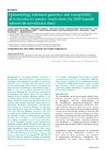Epidemiology, resistance genomics and susceptibility of acinetobacter species: results from the 2020 spanish nationwide surveillance study

Ver/
Use este enlace para citar
http://hdl.handle.net/2183/40971
A non ser que se indique outra cousa, a licenza do ítem descríbese como Creative Commons Attribution 4.0 International License (CC-BY 4.0)
Coleccións
- Investigación (FFISIO) [481]
Metadatos
Mostrar o rexistro completo do ítemTítulo
Epidemiology, resistance genomics and susceptibility of acinetobacter species: results from the 2020 spanish nationwide surveillance studyAutor(es)
Data
2024-04Cita bibliográfica
Lasarte-Monterrubio C, Guijarro-Sánchez P, Alonso-Garcia I, Outeda M, Maceiras R, González-Pinto L, Martínez-Guitián M, Fernández-Lozano C, Vázquez-Ucha JC, Bou G, Arca-Suárez J, Beceiro A. Epidemiology, resistance genomics and susceptibility of acinetobacter species: results from the 2020 spanish nationwide surveillance study. Euro Surveill. 2024 Apr;29(15):2300352.
Resumo
[Abstract] BackgroundAs increasing antibiotic resistance in Acinetobacter baumannii poses a global healthcare challenge, understanding its evolution is crucial for effective control strategies.AimWe aimed to evaluate the epidemiology, antimicrobial susceptibility and main resistance mechanisms of Acinetobacter spp. in Spain in 2020, and to explore temporal trends of A. baumannii.MethodsWe collected 199 single-patient Acinetobacter spp. clinical isolates in 2020 from 18 Spanish tertiary hospitals. Minimum inhibitory concentrations (MICs) for nine antimicrobials were determined. Short-read sequencing was performed for all isolates, and targeted long-read sequencing for A. baumannii. Resistance mechanisms, phylogenetics and clonality were assessed. Findings on resistance rates and infection types were compared with data from 2000 and 2010.ResultsCefiderocol and colistin exhibited the highest activity against A. baumannii, although colistin susceptibility has significantly declined over 2 decades. A. non-baumannii strains were highly susceptible to most tested antibiotics. Of the A. baumannii isolates, 47.5% (56/118) were multidrug-resistant (MDR). Phylogeny and clonal relationship analysis of A. baumannii revealed five prevalent international clones, notably IC2 (ST2, n = 52; ST745, n = 4) and IC1 (ST1, n = 14), and some episodes of clonal dissemination. Genes bla OXA-23, bla OXA-58 and bla OXA-24/40 were identified in 49 (41.5%), eight (6.8%) and one (0.8%) A. baumannii isolates, respectively. ISAba1 was found upstream of the gene (a bla OXA-51-like) in 10 isolates.ConclusionsThe emergence of OXA-23-producing ST1 and ST2, the predominant MDR lineages, shows a pivotal shift in carbapenem-resistant A. baumannii (CRAB) epidemiology in Spain. Coupled with increased colistin resistance, these changes underscore notable alterations in regional antimicrobial resistance dynamics.
Palabras chave
Acinetobacter baumannii
Acinetobacter spp.
CHDLs
WGS
Antimicrobial susceptibility
Epidemiology
Acinetobacter spp.
CHDLs
WGS
Antimicrobial susceptibility
Epidemiology
Versión do editor
Dereitos
Creative Commons Attribution 4.0 International License (CC-BY 4.0)
ISSN
1025-496X






